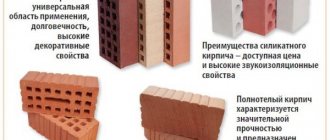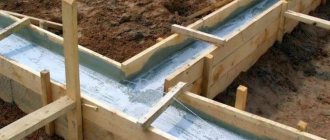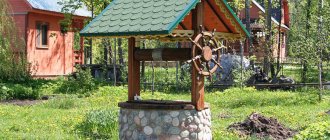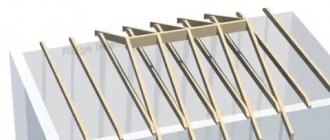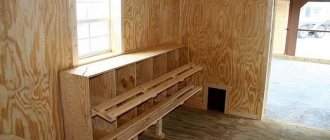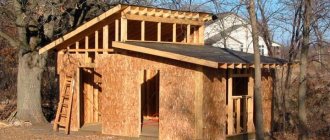If necessary, brick production is carried out at home on your own. Having understood the stages of production, choosing the right material and manufacturing method, you can stock up on building materials without large material costs. The technology for preparing laying elements must be observed as much as possible, since if it is violated, the result will be spoiled.
Equipment and inventory
Don't think that all this is expensive equipment. On the secondary market all this is sold at low prices. For example, a used concrete mixer with a volume of 180 liters can be found for 5,000 rubles. A new deep vibrator can be purchased at a cost from 2000 to 5000 rubles. You can also make a concrete platform yourself, spending 7,000-10,000 rubles.
The simplest concrete mixer is suitable for home production.
You will also need auxiliary tools: bayonet and scoop shovels, trowel, buckets, plastic container, hacksaw, hammer, set of keys and screwdrivers, garden cart. Another cost item will be cellophane film, which will be needed when drying finished products. Most of the listed equipment is available in almost every home and the purchase of these items does not need to be included in the overall budget.
The deep vibrator can be selected in any modification
Forms
To produce a block, you will need molds and they can be made from plywood, metal, or wood. The block size is 200x200x400 mm. The optimal and inexpensive formwork would be board formwork. A board with a wall height of 200 mm and a thickness of at least 25 mm is suitable for this. The boards should be soaked in hot used machine oil. This will give them protection from moisture and extend their service life. From the prepared board it is necessary to twist cells using self-tapping screws, which in terms of internal volume must correspond to the size of the block. The best option for wooden formwork is longitudinal sections of 4 cells.
Scheme for constructing a mold for a block made of boards
Plywood formwork is a more expensive option, but moisture-resistant plywood has its advantages. If you make molds from plywood, the geometry of the product will be even and the surface will be smooth. Using plywood forms you can make a colored facing block. This block is suitable for building a house, garage, bathhouse, fence, and outbuildings. Its advantage is that the color block looks presentable and does not require additional cladding.
Collapsible metal mold option
Metal forms are the most expensive, but also the most practical. They are characterized by a long service life and increased functionality. Metal formworks can be made collapsible, which will significantly speed up the production process and facilitate their transportation and storage. In metal forms, vibration is not dampened, which allows the mixture to remove air better and faster.
Single collapsible form
Brickwork Tools
For a high-quality result, the following tools are required:
- Construction level - without it it will not be possible to lay bricks in even rows.
- A round twig with a diameter of 1 cm - for jointing.
- A square metal rod with a cross-section of 1*1 cm - in order to form identical seams between the rows.
- Angle grinder with diamond discs - used for cutting bricks
- Pick-hammer – used to split facing material.
- Trowel - you can use it to apply mortar, remove excess, and trim the brick when laying.
You will also need thin construction cord or strong thread, anchors and knitting wire to connect the masonry to the load-bearing walls.
Consumables
The consumables you will need are: cement grade M 400 or M 500, construction sand, filler, plasticizer C3. There are no problems with purchasing a plasticizer. It is sold in places where cement is sold or where material for making paving slabs is sold. Separately, it is worth considering the filler, or as it can also be called: the main component of the block.
In different regions, there are different types of fillers used in the production of concrete products. In regions where clay is available, expanded clay is common. In places where a lot of coal is used, slag is present in large quantities. Also, throughout the country you can easily buy crushed stone or screenings. In some cases, broken bricks and concrete chips are used to produce concrete products.
Expanded clay gravel
The filler should be selected according to the intended use of the brick. If the goal is to make the building warm, then slag is perfect. But such a block is suitable only for one-story buildings with a light roof, since slag is a lightweight material, has air pores and cannot bear a large load. If you choose expanded clay as a filler, then you should buy only structural, fine-grained expanded clay. It is capable of bearing loads and can be used to build buildings up to three floors.
Crushed stone fraction 10 - 20 mm
In cases where the building has a height of up to five floors and is equipped with concrete floors, it is necessary to produce the block using crushed stone. Crushed stone of fraction 5 - 10, or 10 - 20 mm is suitable for these purposes. Such a product will be much heavier than a block made of expanded clay or slag, but it is worth considering that it will be subject to a greater load.
Composition of blanks
Before making a fragment manually, you need to know what elements to include in the composition in order to improve the performance properties of the material. The main ingredient is clay, but depending on the purpose, the components of the building mixture include additional components. Based on their contents, the following types of bricks from scrap materials are distinguished:
- Silicate - consists of quartz sand and lime in a ratio of 90% to 10%.
- Red refractory brick - made from clay and plasticizer.
- Ceramic material can be prepared from a constantly used composition and clay admixtures of small fractions.
Before making bricks from cement or other material, you must consult with a specialist, because there are different subtleties in mixing, storing or calculating raw materials. Therefore, in order for the masonry to be durable and look professional, you need to know exactly how to use manual force. Homemade clay brick will be warmer if sawdust or plasticizer is added to it, and if the fragments are reinforced with cement, the installation will last longer.
About the plasticizer
The plasticizer is one of the best inventions that made it possible to produce high-quality concrete at home. With the use of this additive, concrete was able to avoid steaming. Also, with the use of a plasticizer, pressing can be eliminated, since air is removed much more efficiently in the moving mixture.
Advantages of plasticizer:
- increasing the mobility of concrete mortar;
- reducing the amount of water in the solution;
- reducing concrete porosity;
- reducing the product molding time by three times;
- rapid strength gain;
- strengthening the characteristics of ready-made concrete (frost resistance, strength, moisture resistance);
- ease of placing the mixture into molds.
The cost of the plasticizer is 50 rubles per kilogram, but its share in one product is minimal. The plasticizer is dissolved in mixing water in a ratio of 1:100. That is, for 100 liters of water you only need to add 1 kilogram of dry powder. If we recalculate for one finished block, then the cost of the plasticizer will be 30 kopecks per unit of product.
Dry plasticizer
Burning
For firing you will need a furnace, which you can also make yourself. You can build it in a large barrel. To do this, dig a hole half a meter deep, put material for lighting a fire at its bottom, and install legs 20 centimeters high above it. Place an iron barrel on them.
In this improvised oven, bricks are stacked in several rows. After filling, the structure is covered with a sheet of metal, and a fire is built under it. The firing process lasts approximately 18–20 hours, during which time the fire must be constantly maintained.
After this time is over, we gradually reduce the intensity of the fire, and then completely extinguish it. Under no circumstances should the metal sheet be removed until the barrel and its contents have completely cooled. Otherwise, the bricks will crack.
Cooling should occur slowly, naturally, without sudden temperature changes and without drafts. This is the only way you can get a quality product.
Next, take one of the finished bricks and split it in half. Carefully inspect the fault. It must have the same color and structure. Then immerse these pieces in water and wait for some time. If everything is in order, that is, there is no damage or color distortion, then such bricks can be safely used in construction.
Production technology
Any production must begin with the purchase of material. Mandatory components are cement, sand, plasticizer, filler. All this should be ordered, delivered to your site and placed in close proximity to the production site. Cement and plasticizer must be stored in a dry place. A garage or shed is suitable for this. Bulk materials must be protected from precipitation with a thick film.
Step 1. Platform and forms
First of all, you need to prepare the work area. To do this, you need to supply electricity to the concrete mixer and prepare an extension cord for the deep vibrator. Also, you need to prepare mixing water in the required quantity. For one working day, 200 liters of water diluted with a plasticizer will be enough.
You should also assemble the formwork and lubricate its walls with used machine oil. This is necessary in order to avoid sticking of the cement mixture to the walls. The formwork should be placed on a concrete platform in such a way that it is convenient to walk between them. The necessary equipment must be at hand.
Step 2. Kneading
The kneading is done as follows. First, cement, sand and filler are placed in the concrete mixer. The mixture ratio should be as follows: 1 part cement, 2 parts construction sand, 4 parts filler (expanded clay, crushed stone or slag). All components must be poured into a concrete mixer and dry mixed for five minutes.
After the mixture has been mixed, you need to add mixing water. The amount of water needs to be determined by eye, but it is worth knowing one proportion. Water is calculated based on the amount of cement used. To calculate it, there is a special coefficient by which the volume of water is determined. For the production of a concrete block by vibration casting, the coefficient is 0.4. That is, if one batch with a proportion of 1:6 takes 50 kg of cement, then the weight of the cement is multiplied by 0.4 and the amount of water required in liters is obtained. 50x0.4=20 liters of mixing water. Water must be administered in small portions until the desired concentration is achieved. The mixture must be stirred for 15 - 20 minutes.
The peculiarities of humidity in each region should be taken into account. If the filler is wet, then the amount of water should be reduced, and if it is dry, then increased. The solution should resemble thick sour cream and not spread. You need to know that a high amount of moisture in the solution spoils the concrete. Excess water leaves pores in the concrete, making it brittle.
Step 3. Laying
When the mixture is ready, you need to start pouring. The finished mixture must be placed into molds using a bucket and trowel. From the batch, you need to leave a bucket of solution, which will be used for refilling the molds after the vibrator is in operation.
Making blocks without using a vibrator
When the mixture is laid out in molds, you should begin laying it. This is done using a deep vibrator. The working part of the vibrator is placed in a mold filled with the mixture. When laying the mixture, you need to go to all corners of the mold. This is necessary to eliminate air pores. When the mixture shrinks due to vibration, the solution should be added to the desired level. To make the block the same size, the form must be filled to the very top.
After molding is done, it is necessary to cover the molds with cellophane film. This is no less important stage in the manufacture of concrete products than the pouring or preparation of the components itself. Concrete must mature, not dry. Products should not be allowed to ripen in the open sun or exposed to wind. During the aging process, concrete releases heat that must be retained. Under the film, the concrete will undergo a procedure reminiscent of steaming. The brick should remain in this state for 24 hours.
Step 4. Unmolding and storage
After a day, the block can be removed from the molds. If plywood or wooden forms are used, they should be carefully disassembled. This will prevent the edges of the product from chipping. Do not shake products out of molds. When using metal molds, you can remove the products by pressing from above. If the correct geometry is observed in the metal mold, the product will come out easily.
Unmolding a block from a metal mold
The finished brick must be placed in rows on a pallet and covered again with film. One of the best storage options is the use of stretch film, which is used to wrap bricks on a pallet. It will not only retain beneficial moisture, but will also prevent the contents from falling during transportation. The block can be used for construction already on the fifth day after production.
Drying the block in the open area
Calculation of the required number of bricks
For every thousand bricks you will need two and a half cubic meters of raw materials. It remains to find out how many of those thousands we need. Let's first briefly go over the theory. Brick blocks come in the following types and sizes:
- single - 250120x65 millimeters. This is a standard brick that is most often used in construction work,
- one and a half - 250120x88 millimeters,
- double - 250120x138 millimeters.
It is clear that one-and-a-half and double got their name because of their size relative to single. Since they are larger, the construction of the wall is faster, but there are some nuances. Firstly, masonry made from single bricks looks neat and excellent even without finishing.
We have all seen the most beautiful houses made of this material, which do not need any additional decoration. But from one-and-a-half and double blocks, the surface looks rough and is not very pleasing to the eye, so you usually have to add a decorative coating to such masonry.
Secondly, since we are talking about home production, we will make solid bricks. That is, those who have no voids inside. The pore volume in such blocks does not exceed 13% of the total. So, there will be no problems with the single and one-and-a-half versions, but a double brick made in this way will weigh a little more than seven kilograms.
Imagine how you will carry out the laying. You will have to lift a very large and, moreover, heavy stone with one hand. And this needs to be done not just once, but several thousand times in a row. In general, I don’t recommend this option; it’s better to take more single ones and lay out the walls in two rows.
By the way, about the rows. Of course, how many bricks you need also depends on their quantity. In general, there are established average indicators derived by experienced builders. To calculate them, two factors were taken into account: the thickness of the future wall and the dimensions of the brick. This data is quite usable. In addition, they are calculated taking into account the thickness of the seams between the rows and butts of the blocks, which is very convenient. So:
- wall thickness 12 cm, half-brick laying - per square meter you will need 51 single blocks, or 39 one-and-a-half blocks, or 26 double blocks,
- wall thickness 25 cm, masonry in one whole brick - 102 single, 78 one-and-a-half, 52 double,
- wall thickness 38 cm, masonry of one and a half bricks - 153 single, 117 one and a half, 78 double,
- wall thickness 51 cm, two-brick laying - 204 single, 156 one-and-a-half, 104 double,
- wall thickness 64 cm, masonry of two and a half bricks - 255 single, 195 one and a half, 130 double.
Once you have decided on the thickness of the walls, you can begin specific calculations. First, calculate the perimeter of the future building, that is, the sum of the lengths of all its external walls. Then we multiply this indicator by the height of the structure, thereby obtaining the area.
If the building has doors, windows, arches and similar places not filled with bricks, you need to separately calculate their area, and then subtract this indicator from the total. Multiply the resulting number by the corresponding number of bricks from the table.
If you plan to erect internal partitions in the building, then make a calculation for each of them in the manner described above. Then add up all the results. Now you have information about how many bricks you need to make. You can start extracting the source material.
Don't be lazy to make all these calculations. They take very little time. By estimating the number by eye, you run the risk of ending up making too few blocks, and then having to go through the whole path again. Or, on the contrary, you will produce a bunch of bricks, spending a lot of time on it, and then half of them will not be useful. Therefore, preliminary routine meetings with a calculator are very important; they save time, nerves, and money.
Benefits from a home workshop
Such events are conceived only for economic benefit and it is not difficult to calculate. This can be done in a very simple way. The average weight of the block is 20 kg. If we convert all the material used into tons, it turns out that 1 ton of cement, 2 tons of sand, 4 tons of filler were spent on a conventional production cycle. This amount of product will require 6 kg of plasticizer, which will cost 300 rubles. As an example, a building block made of crushed stone is given.
Cost of consumables:
- cement 1 ton – 5000 rub.
- sand 2 tons – 800 rub.
- crushed stone 4 tons – 2400 rub.
- plasticizer 6 kg. – 300 rub.
The total cost is 8,500 rubles.
This amount will yield 6 tons of finished products or 300 blocks. The cost amount of 8500 must be divided into 300 blocks, which will give the raw material cost per unit of goods. Thus, the raw material cost of the block amounted to 28.3 rubles. 1.7 rubles should be allocated for energy costs.
House wall made of solid block
Why is it convenient to make gypsum stone at home?
1. Convenient molds for casting stone, non-bulky, take up little space.2. No vibration table required.3. Clear and simple painting technology.
4. Low cost of mixtures and substances for producing the material.
In addition to making gypsum stone to decorate their premises, many are engaged in its production for commercial purposes. The costs are low and the payback is quick. Moreover, the product is in great demand in the construction market.
Savings in numbers
The average retail cost of such a block is 40 rubles. The savings from home production are obvious and if you need to build a house that will take 8,000 blocks, you can save 80,000 rubles. But the house always needs a garage, a bathhouse, outbuildings, and the purchased equipment will not stand idle. We can conclude that making bricks with your own hands is a profitable business, which, in addition to benefiting your own household, will bring profit from sales.
Also, it is worth considering that in order to save money, you can regulate the quality of products and prevent overconsumption of expensive material. For example, a two-story house requires 10,000 building blocks. The first floor will bear a large load and it is better to lay it out of a high-grade block made of structural expanded clay (expanded clay gravel) or crushed stone. The best option for the second floor would be a block made of cheaper thermal expanded clay (expanded clay crushed stone).
The best option for partitions and interior walls is crushed stone. Such walls have increased sound insulation and hold anchors well for hanging furniture, household appliances, and electronics. The combined use of various types of filler for the construction of one object will improve the quality of construction and save up to 30,000 rubles for every 10,000 blocks.
Subscribe to our Telegram channelExclusive posts every week
